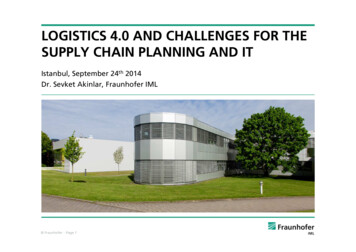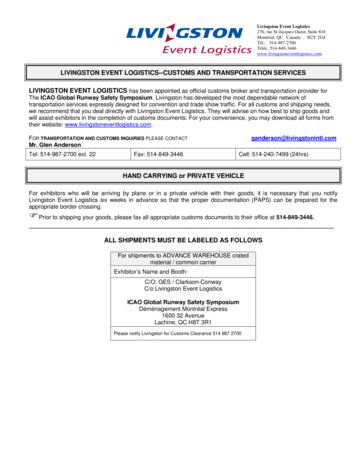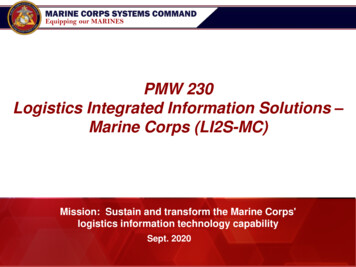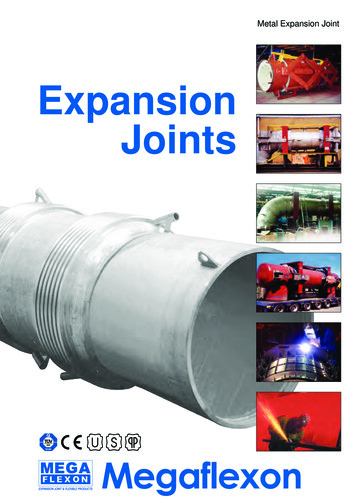Transcription
Joint Logistics Lexicon01 March 2011
Intentionally Blank
THE JOINT STAFFWASHINGTON, DCReply ZIP Code:20318-40001 March 2011MEMORANDUM FOR LOGISTICS COMMUNITY OF INTERESTSubject: Joint Logistics Lexicon1. The lack of a shared language has created or exacerbated many of the challenges toachieving the Logistics Community’s vision of integrated logistics capabilities and,ultimately, freedom of action for the joint warfighter. To begin addressing thisdeficiency, Joint Staff, J-4, in coordination with Joint Staff, J-7 and logisticsrepresentatives from the Combatant Commands, Services, Office of the Secretary ofDefense, and the Defense Logistics Agency, developed this joint logistics lexicon toprovide the Logistics Community with a single, consolidated list of approved andemerging logistics terms to help facilitate logistics interoperability through a commonoperating language.2. The lexicon consists of two sections. The first section, “Part I: Authorized JP 1-02Terminology”, contains approved logistics terms derived from Joint Publication 1-02,Department of Defense Dictionary of Military and Associated Terms. The secondsection, “Part II: Developmental Terminology”, consists of terms and definitions createdduring the staffing of the lexicon; terms and concepts the Logistics Community feltlogisticians should know to more effectively operate within the joint environment. TheLogistics Community of Interest organization who provided the term was also includedat the end of each definition.3. The developmental terms were derived from a variety of sources such as Service,functional area, and joint conceptual documents and instructions. Logistics relatedterms used but not defined in 3.0 and 4.0 series joint publications were included as well.Furthermore, terms commonly used within some circles of the Logistics Community thathave not been used or defined in a formal Service, functional area, or joint publicationwere also included for consideration to be formalized into legitimate logistics terms dueto their potential broader applicability and future utility. The intent for the developmentalterms is to propose them for inclusion into an applicable joint publication and eventuallycodify them into Joint Publication 1-02.4. My intent is to update this lexicon on an annual basis. Moreover, this new lexiconwill be a living, enduring document that will serve as a mechanism by which theLogistics Community can continue to identify terms and definitions we believe need tobe codified into the joint publication collection to further develop a formal andcomprehensive joint logistics common operating language over the long term. Towardsthis end, support from the Logistics Community is essential to assist Joint Staff J4 toi
Subject: Joint Logistics Lexiconcontinue to identify and submit terms and definitions that our logisticians need to knowto be successful joint logisticians during future lexicon and joint publication updates.5. Please provide feedback on this lexicon and future terminology submissions to mylexicon program POC at e-mail: JSJ4jointloglexicon@js.pentagon.mil. For terminologysubmissions, please provide the term to include the document, page, and paragraphwhere the term was used, rationale for why the term is useful for joint logisticians toknow, the appropriate joint publication where the term should be inserted, and aproposed definition written based on the context in which the term was used and inaccordance with CJCSI 5705.01D, Enclosure C, Definition Writing Guide.6. Thank you for your support to help mature the Logistics Community’s operatinglanguage towards enhancing our interoperability and warfighting effectiveness.KATHLEEN M. GAINEYLieutenant General, USADirector of Logistics, J-4ii
Part I: Authorized JP 1-02 TerminologyAacquisition and cross-servicing agreement — Agreements negotiated on a bilateral basis withUS allies or coalition partners that allow US forces to exchange most common types ofsupport, including food, fuel, transportation, ammunition, and equipment. Authority tonegotiate these agreements is usually delegated to the combatant commander by theSecretary of Defense. Authority to execute these agreements lies with the Secretary ofDefense, and may or may not be delegated. Governed by legal guidelines, these agreementsare used for contingencies, peacekeeping operations, unforeseen emergencies, or exercisesto correct logistic deficiencies that cannot be adequately corrected by national means. Thesupport received or given is reimbursed under the conditions of the acquisition and crossservicing agreement. Also called ACSA. See also cross-servicing; servicing. (JP 4-08)activation — Order to active duty (other than for training) in the federal service. See also activeduty; federal service. (JP 4-05)active duty — Full-time duty in the active military service of the United States. This includesmembers of the Reserve Component serving on active duty or full-time training duty, butdoes not include full-time National Guard duty. Also called AD. See also active duty fortraining; inactive duty training. (JP 4-05)active sealift forces — Military Sealift Command active, common-user sealift and the afloatpre-positioning force, including the required cargo handling and delivery systems as well asnecessary operating personnel. See also afloat pre-positioning force; common-usersealift; Military Sealift Command. (JP 4-01.2)acute care services — Medical services provided for patients with conditions that generallyhave a rapid onset and follow a short course or require immediate attention. Mostbattlefield care rendered after wounding, illness, or injury onset is acute care service. Acutecare service is delivered after the onset of symptoms, which differentiates it frompreventive care that is delivered before symptoms appear. (JP 4-02)administrative contracting officer — Contracting officer whose primary duties involvecontract administration. Also called ACO. See also contracting officer; procuringcontracting officer. (JP 4-10)aeromedical evacuation — The movement of patients under medical supervision to andbetween medical treatment facilities by air transportation. Also called AE. (JP 4-02)aeromedical evacuation coordination center — A coordination center within the joint airoperations center’s airlift coordination cell that monitors all activities related toaeromedical evacuation (AE) operations execution. It manages the medical aspects of theAE mission and serves as the net control station for AE communications. It coordinatesI-1
JP 1-02 Termsmedical requirements with airlift capability, assigns medical missions to the appropriateAE elements, and monitors patient movement activities. Also called AECC. See alsoaeromedical evacuation; aeromedical evacuation system; aeromedical evacuationunit. (JP 4-02.2)aeromedical evacuation system — A system that provides: a. control of patient movement byair transport; b. specialized medical aircrew, medical crew augmentees, and specialtymedical attendants and equipment for inflight medical care; c. facilities on or in the vicinityof air strips and air bases for the limited medical care of intransit patients entering, en routevia, or leaving the system; and d. communication with originating, destination, and en routemedical facilities concerning patient transportation. Also called AES. See alsoaeromedical evacuation. (JP 4-02.2)afloat pre-positioning force — Shipping maintained in full operational status to afloatpreposition military equipment and supplies in support of combatant commanders’operation plans. The afloat pre-positioning force consists of the three maritimeprepositioning ships squadrons, the Army’s afloat pre-positioning stocks-3 ships, and theNavy, Defense Logistics Agency, and Air Force ships. Also called APF. See alsomaritime pre-positioning ships. (JP 4-01.2)afloat pre-positioning operations — Pre-positioning of ships, preloaded with equipment andsupplies (including ammunition and petroleum) that provides for an alternative to landbased programs. This concept provides for ships and onboard force support equipment andsupplies positioned near potential crisis areas that can be delivered rapidly to joint airliftedforces in the operational area. Afloat pre-positioning in forward areas enhances a force’scapability to respond to a crisis, resulting in faster reaction time. See also operation. (JP4-01.6)afloat pre-positioning ships — Forward deployed merchant ships loaded with tacticalequipment and supplies to support the initial deployment of military forces. Also calledAPS. See also merchant ship. (JP 4-01.2)ambulance exchange point — A location where a patient is transferred from one ambulance toanother en route to a medical treatment facility. This may be an established point in anambulance shuttle or it may be designated independently. Also called AXP. See alsomedical treatment facility. (JP 4-02.2)amphibian — A small craft, propelled by propellers and wheels or by air cushions for thepurpose of moving on both land and water. (JP 4-01.6)amphibious bulk liquid transfer system — Hosereel system providing capability to deliverfuel and/or water from ship to shore. System includes 10,000 feet of 6" buoyant hose forfuel, and 10,000 ft of 4" buoyant hose for water. System are deployed on Maritime Prepositioning Ships Squadrons, and are normally used in direct support of maritime prepositioning force operations. Also called ABLTS. (JP 4-01.6)I-2
JP 1-02 Termsanchorage — A specified location for anchoring or mooring a vessel in-stream or offshore. (JP4-01.6)antemortem identification media — Records, samples, and photographs taken prior to death.These include (but are not limited to) fingerprints, dental x-rays, body tissue samples,photographs of tattoos, or other identifying marks. These “predeath” records would becompared against records completed after death to help establish a positive identification ofhuman remains. See also mortuary affairs. (JP 4-06)assembly area — 1. An area in which a command is assembled preparatory to further action.2. In a supply installation, the gross area used for collecting and combining componentsinto complete units, kits, or assemblies. (JP 4-09)asset visibility — Provides users with information on the location, movement, status, andidentity of units, personnel, equipment, and supplies. It facilitates the capability to act uponthat information to improve overall performance of the Department of Defense’s logisticspractices. Also called AV. (JP 3-35)automated identification technology — A suite of tools for facilitating total asset visibilitysource data capture and transfer. Automated identification technology includes a variety ofdevices, such as bar codes, magnetic strips, optical memory cards, and radio frequency tagsfor marking or “tagging” individual items, multi-packs, equipment, air pallets, orcontainers, along with the hardware and software required to create the devices, read theinformation on them, and integrate that information with other logistic information. Alsocalled AIT. (JP 3-35)automation network — The automation network combines all of the information collectiondevices, automatic identification technologies, and the automated information systems thateither support or facilitate the joint reception, staging, onward movement, and integrationprocess. See also automated identification technology; joint reception, staging, onwardmovement, and integration. (JP 3-35)Bbackfill — Reserve Component units and individuals recalled to replace deploying active unitsand/or individuals in the continental United States and outside the continental UnitedStates. See also Reserve Component. (JP 4-05)backshore — The area of a beach extending from the limit of high water foam lines to dunes orextreme inland limit of the beach. (JP 4-01.6)backwash — An even layer of water that moves along the sea floor from the beach through thesurf zone and caused by the pile-up of water on the beach from incoming breakers. (JP4-01.6)I-3
JP 1-02 Termsbar — A submerged or emerged embankment of sand, gravel, or mud created on the sea floor inshallow water by waves and currents. A bar may be composed of mollusk shells. (JP4-01.6)barge — A flat-bed, shallow-draft vessel with no superstructure that is used for the transport ofcargo and ships’ stores or for general utility purposes. See also watercraft. (JP 4-01.6)barrier — A coordinated series of obstacles designed or employed to channel, direct, restrict,delay, or stop the movement of an opposing force and to impose additional losses inpersonnel, time, and equipment on the opposing force. Barriers can exist naturally, be manmade, or a combination of both. (JP 3-15)barrier, obstacle, and mine warfare plan — A comprehensive, coordinated plan that includesresponsibilities; general location of unspecified and specific barriers, obstacles, andminefields; special instructions; limitations; coordination; and completion times. The planmay designate locations of obstacle zones or belts. It is normally prepared as an annex to acampaign plan, operation plan, or operation order. (JP 3-15)base — 1. A locality from which operations are projected or supported. 2. An area or localitycontaining installations which provide logistic or other support. See also establishment. 3.Home airfield or home carrier. See also base of operations; facility. (JP 4-0)base development (less force beddown) — The acquisition, development, expansion,improvement, and construction and/or replacement of the facilities and resources of an areaor location to support forces employed in military operations or deployed in accordancewith strategic plans. (JP 3-34)basic load — The quantity of supplies required to be on hand within, and which can be movedby, a unit or formation. It is expressed according to the wartime organization of the unit orformation and maintained at the prescribed levels. (JP 4-09)battle damage repair — Essential repair, which may be improvised, carried out rapidly in abattle environment in order to return damaged or disabled equipment to temporary service.Also called BDR. (JP 4-09)battle injury — Damage or harm sustained by personnel during or as a result of battleconditions. Also called BI. (JP 4-02)beachmaster unit — A commissioned naval unit of the naval beach group designed to provideto the shore party a Navy component known as a beach party, which is capable ofsupporting the amphibious landing of one division (reinforced). Also called BMU. See alsobeach party; naval beach group; shore party. (JP 4-01.6)berm, natural — The nearly horizontal portion of a beach or backshore having an abrupt falland formed by deposition of material by wave action. A berm marks the limit of ordinaryI-4
JP 1-02 Termshigh tide. For air cushion vehicles, berms (constructed) are required to protect materialshandling equipment operations. See also backshore. (JP 4-01.6)bight — A bend in a coast forming an open bay or an open bay formed by such a bend. (JP4-01.6)bottom mine — A mine with negative buoyancy which remains on the seabed. Also calledground mine. See also mine. (JP 3-15)breakbulk cargo — Any commodity that, because of its weight, dimensions, or incompatibilitywith other cargo, must be shipped by mode other than military van or military containermoved via the sea. See also breakbulk ship. (JP 4-09)breakbulk ship — A ship with conventional holds for stowage of breakbulk cargo, below orabove deck, and equipped with cargo-handling gear. Ships also may be capable of carryinga limited number of containers, above or below deck. See also breakbulk cargo. (JP 4-09)breaker — A wave in the process of losing energy where offshore energy loss is caused by windaction and nearshore energy loss is caused by the impact of the sea floor as the wave entersshallow (shoaling) water. Breakers either plunge, spill, or surge. See also breaker angle.(JP 4-01.6)breaker angle — The angle a breaker makes with the beach. See also breaker. (JP 4-01.6)broach — When a water craft is thrown broadside to the wind and waves, against a bar, oragainst the shoreline. (JP 4-01.6)buddy-aid — Acute medical care (first aid) provided by a non-medical Service member toanother person. (JP 4-02)building systems — Structures assembled from manufactured components designed to providespecific building configurations (e.g., large steel arch structures, large span tension fabricstructures, panelized buildings, and pre-engineered buildings). (JP 3-34)bulk petroleum product — A liquid petroleum product transported by various means andstored in tanks or containers having an individual fill capacity greater than 250 liters. (JP4-03)Ccantilever lifting frame — Used to move Navy lighterage causeway systems on to and off oflighter aboard ship (LASH) vessels. This device is suspended from the Morgan LASHbarge crane and can lift one causeway section at a time. It is designed to allow the longsections to clear the rear of the ship as they are lowered into the water. Also called CLF.See also causeway; lighterage. (JP 4-01.6)I-5
JP 1-02 Termscasualty — Any person who is lost to the organization by having been declared dead, duty status– whereabouts unknown, missing, ill, or injured. See also casualty category; casualtystatus; casualty type; duty status – whereabouts unknown; hostile casualty; nonhostilecasualty. (JP 4-02)casualty category — A term used to specifically classify a casualty for reporting purposes basedupon the casualty type and the casualty status. Casualty categories include killed in action,died of wounds received in action, and wounded in action. See also casualty; casualtystatus; casualty type; duty status - whereabouts unknown; missing. (JP 4-02)casualty evacuation — The unregulated movement of casualties that can include movementboth to and between medical treatment facilities. Also called CASEVAC. See alsocasualty; evacuation; medical treatment facility. (JP 4-02)casualty status — A term used to classify a casualty for reporting purposes. There are sevencasualty statuses: (1) deceased; (2) duty status - whereabouts unknown; (3) missing; (4)very seriously ill or injured; (5) seriously ill or injured; (6) incapacitating illness or injury;and (7) not seriously injured. See also casualty; casualty category; casualty type;deceased; duty status - whereabouts unknown; missing; not seriously injured;seriously ill or injured; very seriously ill or injured. (JP 4-02)casualty type — A term used to identify a casualty for reporting purposes as either a hostilecasualty or a nonhostile casualty. See also casualty; casualty category; casualty status;hostile casualty; nonhostile casualty. (JP 4-02)causeway — A craft similar in design to a barge, but longer and narrower, designed to assist inthe discharge and transport of cargo from vessels. See also barge; watercraft. (JP 4-01.6)civil augmentation program — Standing, long-term external support contacts designed toaugment Service logistic capabilities with contracted support in both preplanned and shortnotice contingencies. Examples include US Army Logistics Civil Augmentation Program,Air Force Contract Augmentation Program, and US Navy Global Contingency CapabilitiesContracts. Also called CAP. See also contingency; contingency contract; externalsupport contract. (JP 4-10)civil-military medicine — A discipline within operational medicine comprising public healthand medical issues that involve a civil-military interface (foreign or domestic), includingmilitary medical support to civil authorities (domestic), medical engagement cooperationactivities, and medical civil-military operations. (JP 4-02)classes of supply — The ten categories into which supplies are grouped in order to facilitatesupply management and planning. I. Rations and gratuitous issue of health, morale, andwelfare items. II. Clothing, individual equipment, tentage, tool sets, and administrative andhousekeeping supplies and equipment. III. Petroleum, oils, and lubri
afloat pre-positioning ships — Forward deployed merchant ships loaded with tactical equipment and supplies to support the initial deployment of military forces. Also called APS. See also merchant ship. (JP 4-01.2) ambulance exchange point — A loca










